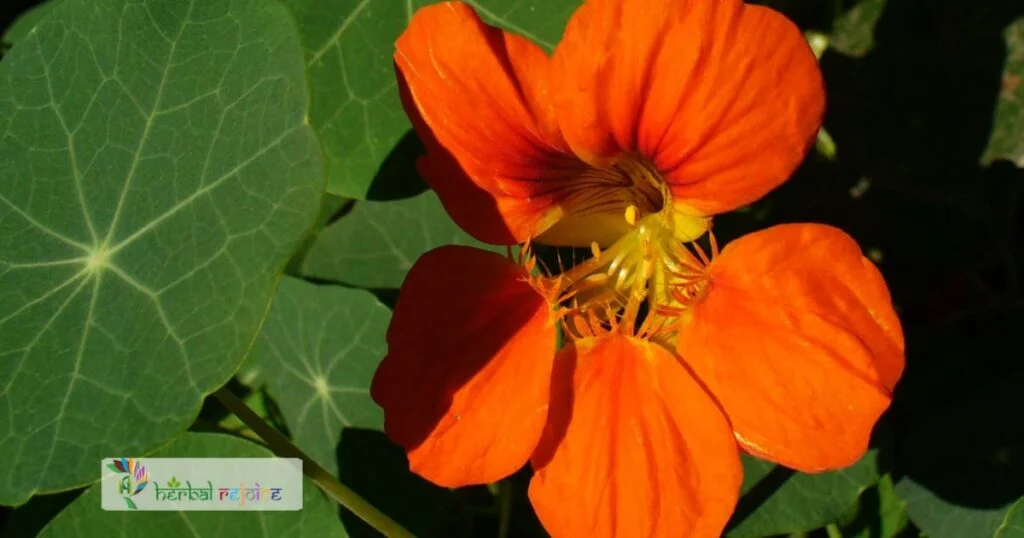Introduction
Tropaeolum majus Linn., commonly known as Garden Nasturtium or Indian Cress, belongs to the Tropaeolaceae family. This plant is native to South America but is widely grown as an ornamental and salad herb.
Garden Nasturtium can be used to boost the body’s immunity, alleviate catarrh, and expel phlegm. The flowers are effective in healing wounds.
Medicinal Properties of Garden Nasturtium
The leaves of Tropaeolum majus have medicinal properties. An infusion of the leaves increases the body’s resistance to bacterial infections, reduces the formation of catarrh, and helps in expelling phlegm.
Additionally, the juice extracted from the plant is used internally for treating scrofula, a condition characterized by inflammation of the lymph nodes.
The flowers of Tropaeolum majus are known for their healing properties and can be used to treat wounds. The seeds have a purgative effect.
Key Components of Garden Nasturtium
Common Nasturtium contains various compounds such as glucocyanates (including glycotropeoline), spilanthol, myrosin (an enzyme), oxalic acid, and vitamin C.
Among these, glucocyanates are responsible for the plant’s antibiotic activity. Studies have shown that the leaves of young Tropaeolum majus plants have stronger antibiotic properties compared to the stems, while the roots do not exhibit any activity.
Extracts and preparations of Tropaeolum majus are effective in treating infections of the urinary and respiratory tract. However, they do not have any effect on infections of the biliary tract or typhoid fever.

Conclusion
In conclusion, Tropaeolum majus Linn., commonly known as Garden Nasturtium or Indian Cress, is a plant with various medicinal uses. Its leaves can be used to boost the body’s immunity, alleviate catarrh, and expel phlegm.
The flowers are effective in healing wounds, and the seeds have purgative properties. Tropaeolum majus contains compounds like glucocyanates, spilanthol, myrosin, oxalic acid, and vitamin C, which contribute to its medicinal effects.
It is an excellent plant to have in your garden for both ornamental and medicinal purposes.
Frequently Asked Questions(FAQs)
What is Tropaeolum majus Linn. commonly known as?
Tropaeolum majus Linn. is commonly known as Garden Nasturtium or Indian Cress.
Which family does Tropaeolum majus belong to?
Tropaeolum majus belongs to the Tropaeolaceae family.
Is Tropaeolum majus native to South America?
Yes, Tropaeolum majus is native to South America.
What are the medicinal properties of the leaves of Tropaeolum majus?
The leaves of Tropaeolum majus have medicinal properties such as increasing the body’s resistance to bacterial infections, reducing the formation of catarrh, and helping in expelling phlegm.
How is the juice extracted from Tropaeolum majus used for medicinal purposes?
The juice extracted from Tropaeolum majus is used internally for treating scrofula, a condition characterized by inflammation of the lymph nodes.
What are the healing properties of the flowers of Tropaeolum majus?
The flowers of Tropaeolum majus have healing properties and can be used to treat wounds.
What effect do the seeds of Tropaeolum majus have?
The seeds of Tropaeolum majus have a purgative effect.
What are the compounds found in Common Nasturtium?
Common Nasturtium contains various compounds such as glucocyanates (including glycotropeoline), spilanthol, myrosin (an enzyme), oxalic acid, and vitamin C.
Which compound in Tropaeolum majus is responsible for its antibiotic activity?
Glucocyanates are responsible for the antibiotic activity of Tropaeolum majus.
Are the leaves or stems of Tropaeolum majus more effective in terms of antibiotic properties?
The leaves of young Tropaeolum majus plants have stronger antibiotic properties compared to the stems.
Do the roots of Tropaeolum majus exhibit any antibiotic activity?
No, the roots of Tropaeolum majus do not exhibit any antibiotic activity.
What infections can extracts and preparations of Tropaeolum majus treat?
Extracts and preparations of Tropaeolum majus have been found to be effective in treating infections of the urinary and respiratory tract.
Which infections do extracts and preparations of Tropaeolum majus not have an effect on?
Extracts and preparations of Tropaeolum majus do not have any effect on infections of the biliary tract or typhoid fever.
Can Tropaeolum majus be used for ornamental purposes?
Yes, Tropaeolum majus is widely grown as an ornamental plant.
What are the benefits of having Tropaeolum majus in your garden?
Having Tropaeolum majus in your garden provides both ornamental beauty and medicinal benefits.
How can Tropaeolum majus boost the body’s immunity?
Tropaeolum majus leaves can boost the body’s immunity due to their medicinal properties.
Can Tropaeolum majus be used to alleviate catarrh?
Yes, Tropaeolum majus leaves can help reduce the formation of catarrh.
What are the benefits of using Tropaeolum majus for wound healing?
The flowers of Tropaeolum majus have healing properties and can be used to treat wounds effectively.
How can the seeds of Tropaeolum majus be used for medicinal purposes?
The seeds of Tropaeolum majus have purgative properties, which can be beneficial for certain conditions.
How can Tropaeolum majus be used for treating infections?
Extracts and preparations of Tropaeolum majus can be used to treat urinary and respiratory tract infections effectively.


